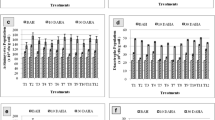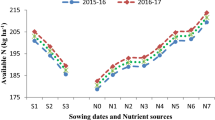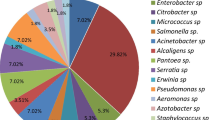Abstract
Plant species, viz Cleistanthus collinus, Lantana camara, and Strychnos nux-vomica are being traditionally used for pest management in rice. However, limited investigation has been carried out to understand the toxic effect of these materials on soil microbes. Hot water extracts of these plants were evaluated for their effects on soil microbial population and enzyme activities along with neem oil and chlorpyrifos as check. Soil microbial population, viz bacteria, fungi, phosphate-solubilizing bacteria (PSB), and asymbiotic nitrogen fixers were unchanged after application of plant extracts. Maximum population of bacteria including PSB and asymbiotic nitrogen fixers were observed in control, whereas, S. nux-vomica, and C. collinus–treated soil had higher number of actinomycetes and fungal population, respectively. Soil microbial biomass did not vary differently among the plant extracts. Application of plant extracts did not alter dehydrogenase, β-glycosidase, acid phosphatase, alkaline phosphatase, and urease content in soil. Secondary metabolites present in these plant extracts may be responsible for variable effects on soil microbes. Chlorpyrifos had a fleeting negative effect on soil microbes and enzymes in comparison to plant extracts. All the three plants did not have any negative effect on soil microbes and enzymes and can be safely recommended in rice pest management.




Similar content being viewed by others
References
Adak, T., Munda, S., Kumar, U., Berliner, J., Pokhare, S. S., Jambhulkar, N. N., & Jena, M. (2016). Effect of elevated CO2 on chlorpyrifos degradation and soil microbial activities in tropical rice soil. Environmental Monitoring and Assessment, 188, 105. https://doi.org/10.1007/s10661-016-5119-4.
Ahirwar, B., Ahirwar, D., & Lanjhiayana, S. (2011). Insecticidal activity of Cleistanthus collinus Roxb. Der Pharma Chemica, 3(1), 49–52.
Akinnifesi, T. A., Asubiojo, O. I., & Amusan, A. A. (2006). Effects of fungicide residues on the physico-chemical characteristics of soils of a major cocoa-producing area of Nigeria. Science of the Total Environment, 366, 876–879.
Bagde, V. L., Borkar, D. B., & Deshmukh, A. G. (2013). Evaluation of insecticidal activity of Cleistanthus ollinus plant extracts and their fractions against lepidopterian pests. Indian Journal of Applied Research, 3(11), 5–7.
Burger, J., Mol, F., & Gerowitt, B. (2008). The ‘necessary extent’ of pesticide use – thoughts about a key term in German pesticide policy. Crop Protection, 27, 343–351.
Campos, E. V. R., de Oliveira, J. L., Pascoli, M., de Lima, R., & Fraceto, L. F. (2016). Neem oil and crop protection: from now to the future. Frontiers in Plant Science, 7, 1494. https://doi.org/10.3389/fpls.2016.01494.
Chaudhary, S., Kanwar, R. K., Sehgal, A., Cahill, D. M., Barrow, C. J., Sehgal, R., & Kanwar, J. R. (2017). Progress on Azadirachta indica based biopesticides in replacing synthetic toxic pesticides. Frontiers in Plant Science, 8, 610.
Chishti, Z., Hussain, S., Arshad, K. R., Khalid, A., & Arshad, M. (2013). Microbial degradation of chlorpyrifos in liquid media and soil. Journal of Environmental Management, 114, 372–380.
Chrispal, A. (2012). Cleistanthus collinus poisoning. Journal of Emergencies, Trauma, and Shock, 5(2), 160–166.
Damalas, C. A. (2009). Understanding benefits and risks of pesticide use. Scientific Research and Essays, 4, 945–949.
El-Kenany, E. T., & El-Darier, S. M. (2013). Suppression effects of Lantana camara L. aqueous extracts on germination efficiency of Phalaris minor Retz. and Sorghum bicolor L. (Moench). Journal of Taibah University for Science, 7(2), 64–71.
Fan, L., Chen, Y., Yuan, J., & Yang, Z. (2010). The effect of Lantana camara Linn. invasion on soil chemical and microbiological properties and plant biomass accumulation in southern China. Geoderma, 154, 370–378.
Gopal, M., Gupta, A., Arunachalam, V., & Magu, S. P. (2007). Impact of azadirachtin, an insecticidal allelochemical from neem on soil microflora, enzyme and respiratory activities. Bioresource Technology, 98, 3154–3158.
Hoskin, M. L. (1961). Mathematical treatment of loss of pesticide residues. FAO Plant Protection Bulletin, 9, 163–169.
Ipsilantis, I., Samourelis, C., & Karpouzas, D. G. (2012). The impact of biological pesticides on arbuscular mycorrhizal fungi. Soil Biology and Biochemistry, 45, 147–155.
Isman, M. B. (2015). A renaissance for botanical insecticides? Pest Management Science, 71(12), 1587–1590.
Jacobsen, C. S., & Hjelmsø, M. H. (2014). Agricultural soils, pesticides and microbial diversity. Current Opinion in Biotechnology, 27, 15–20.
Jena, M. (2012). Botanical–based indigenous technical knowledge (ITK) for rice pest management–with emphasis on tribal farming system. CRRI Research Bulletin No 5. Central Rice Research Institute, Cuttack, India, p. 1-80.
Kačániová, M., Vukovič, N., Horská, E., Šalamon, I., Bobková, A., Hleba, L., & Bobko, M. (2014). Antibacterial activity against Clostridium genus and antiradical activity of the essential oils from different origin. Journal of Environmental Science and Health, Part B, 49(7), 505–512.
Kareru, P., Rotich, Z. K., & Maina, E. W. (2013). Use of botanicals and safer insecticides designed in controlling insects: the African case. In S. Trdan (Ed.), Insecticides - development of safer and more effective technologies (pp. 297–309). InTech. https://doi.org/10.5772/53924.
Kizilkaya, R., Akca, I., Askın, T., Yılmaz, R., Olekhov, V., Samofalova, I., & Mudrykh, N. (2012). Effect of soil contamination with azadirachtin on dehydrogenase and catalase activity of soil. Eurasian Journal of Soil Science, 2, 98–103.
Lo, C. C. (2010). Effect of pesticides on soil microbial community. Journal of Environmental Science and Health. Part. B, Pesticides, Food Contaminants, and Agricultural Wastes, 45, 348–359. https://doi.org/10.1080/03601231003799804.
Lu, M.-X., Jiang, W. W., Wang, J.-L., Jian, Q., Shen, Y., Liu, X.-J., & Yu, X.-Y. (2014). Persistence and dissipation of chlorpyrifos in Brassica Chinensis, lettuce, celery, asparagus lettuce, eggplant, and pepper in a greenhouse. PLoS One, 9(6), e100556. https://doi.org/10.1371/journal.pone.0100556.
Mahapatra, B., Adak, T., Patil, N. K. B., Pandi, G. P. G., Gowda, B. G., Jambhulkar, N. N., Yadav, M. K., Panneerselvam, P., Kumar, U., Munda, S., & Jena, M. (2017). Imidacloprid application changes microbial dynamics and enzymes in rice soil. Ecotoxicology and Environmental Safety, 144, 123–130.
Maheswaran, R., & Ignacimuthu, S. (2013). Bioefficacy of essential oil from Polygonum hydropiper L. against mosquitoes, Anopheles stephensi and Culex quinquefasciatus. Ecotoxicology and Environmental Safety, 97, 26–31.
Mohanty, S., Patra, A. K., & Chhonkar, P. K. (2008). Neem (Azadirachta indica) seed kernel powder retards urease and nitrification activities in different soils at contrasting moisture and temperature regimes. Bioresource Technology, 99(4), 894–899.
Okur, N., Tuna, A. L., Okur, B., Altunlu, Kayikçioğlu, H. H., & Civelek, H. S. (2010). Non-target effect of organic insecticides: effect of two plant extracts on soil microbial biomass and enzymatic activities in soil. Environmental Monitoring and Assessment, 165, 389. https://doi.org/10.1007/s10661-009-0954-1.
Rajashekar, Y., Ravindra, K. V., & Bakthavatsalam, N. (2014). Leaves of Lantana camara Linn. (Verbenaceae) as a potential insecticide for the management of three species of stored grain insect pests. Journal of Food Science and Technology, 51(11), 3494–3499.
Sahoo, S., Adak, T., Bagchi, T. B., Kumar, U., Munda, S., Saha, S., Berliner, J., Jena, M., & Mishra, B. B. (2016). Non-target effects of pretilachlor on microbial properties in tropical rice soil. Environmental Science and Pollution Research, 23, 7595–7602. https://doi.org/10.1007/s11356-015-6026-x.
Sahoo, S., Adak, T., Bagchi, T. B., Kumar, U., Munda, S., Saha, S., Berliner, J., Jena, M., & Mishra, B. B. (2017). Effect of pretilachlor on soil enzyme activities in tropical rice soil. Bulletin of Environmental Contamination and Toxicology, 98(3), 439–445.
Sahu, M., Adak, T., Patil, N. B., Gowda, G. B., Yadav, M. K., Annamalai, M., et al. (2019). Dissipation of chlorantraniliprole in contrasting soils and its effect on soil microbes and enzymes. Ecotoxicology and Environmental Safety, 180, 288–294.
Sarawaneeyaruk, S., Krajangsang, S., & Pringsulaka, O. (2015). The effects of neem extract and azadirachtin on soil microorganisms. Journal of Soil Science and Plant Nutrition, 15(4), 1071–1083.
Sardar, D., & Kole, R. K. (2005). Metabolism of chlorpyrifos in relation to its effect on the availability of some plant nutrients in soil. Chemosphere, 61(9), 1273–1280.
Senthil-Nathan, S., Hisham, A., & Jayakumar, G. (2008). Larvicidal and growth inhibition of the malaria vector Anopheles stephensi by triterpenes from Dysoxylum malabaricum and Dysoxylum beddomei. Fitoterapia, 79, 106–111.
Shaukat, S. S., & Siddiqui, I. A. (2001). Lantana camara in the soil changes the fungal community structure and reduces impact of Meloidogyne javanica on mungbean. Phytopathologia Mediterranea, 40, 245–252.
Sivaraman, G., Paulraj, M. G., Ignacimuthu, S., & Al-Dhabi, N. A. (2014). Bioefficacy of seed extracts of Strychnos nux-vomica and Semicarpus anacardium against Helicoverpa armigera (Hubner) (Lepidoptera: Noctuidae). International Journal of Agricultural and Food Science, 4(2), 73–77.
Spyrou, I. M., Karpouzas, D. G., & Spiroudi, U. M. (2009). Do botanical pesticides alter the structure of the soil microbial community? Microbial Ecology, 58, 715–727. https://doi.org/10.1007/s00248-009-9522-z.
Suciu, N., Vasileiadis, S., Puglisi, E., Pertile, G., Tourna, M., Karas, P. Α., et al. (2019). Azadirachtin and trifloxystrobin had no inhibitory effects on key soil microbial functions even at high dose rates. Applied Soil Ecology, 137, 29–38.
Vance, E. D., Broke, P. C., & Jenkisons, D. S. (1987). Microbial biomass measurements in forest soils: the use of chloroform fumigation-incubation method in strongly acidic soils. Soil Biology and Biochemistry, 19, 697–702. https://doi.org/10.1016/0038-0717(87)90051-4.
Wan, M. T., & Rae, J. E. (1998). Impact of azadirachtin on Glomus intraradices and versicular–arbuscular mycorrhiza in root inducing transferred DNA transformed roots of Daucus carota. Environmental Toxicology and Chemistry, 17, 2041–2050.
Wang, L., Jiao, W., Jiang, X., & Liang, Y. (2013). Abiotic control on the dissipation of chlorpyrifos spiked in an Udic Ferrisol at a lower dosage. Chemical Ecology, 29, 724–732.
Zhang, X., Shen, Y., Yu, X., & Liu, X. (2012). Dissipation of chlorpyrifos and residue analysis in rice, soil and water under paddy field conditions. Ecotoxicology and Environmental Safety, 78, 276–280.
Funding
Authors duly acknowledge the financial support provided by the Director, ICAR-National Rice Research Institute, Cuttack under ICAR-NRRI/In-house project 3.5/2012-2017 scheme (Fund received by Dr. Totan Adak).
Author information
Authors and Affiliations
Corresponding author
Ethics declarations
Competing interest
The authors declare that they have no competing interests.
Additional information
Publisher’s note
Springer Nature remains neutral with regard to jurisdictional claims in published maps and institutional affiliations.
Rights and permissions
About this article
Cite this article
Mishra, T., Govindharaj, GPP., Gadratagi, B.G. et al. Deciphering the associated risk on soil microbes upon use of biopesticides in rice ecosystem. Environ Monit Assess 191, 654 (2019). https://doi.org/10.1007/s10661-019-7823-3
Received:
Accepted:
Published:
DOI: https://doi.org/10.1007/s10661-019-7823-3




